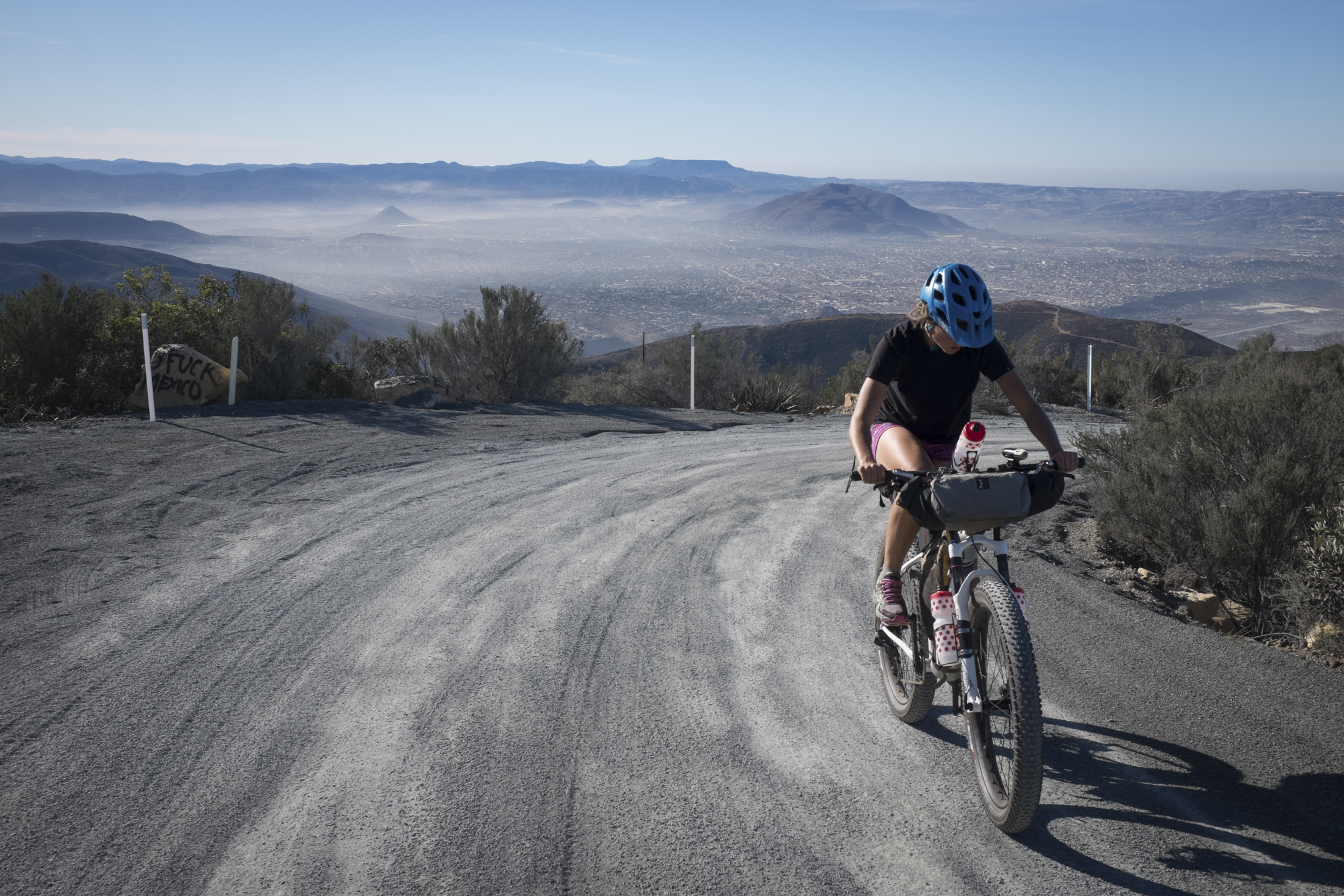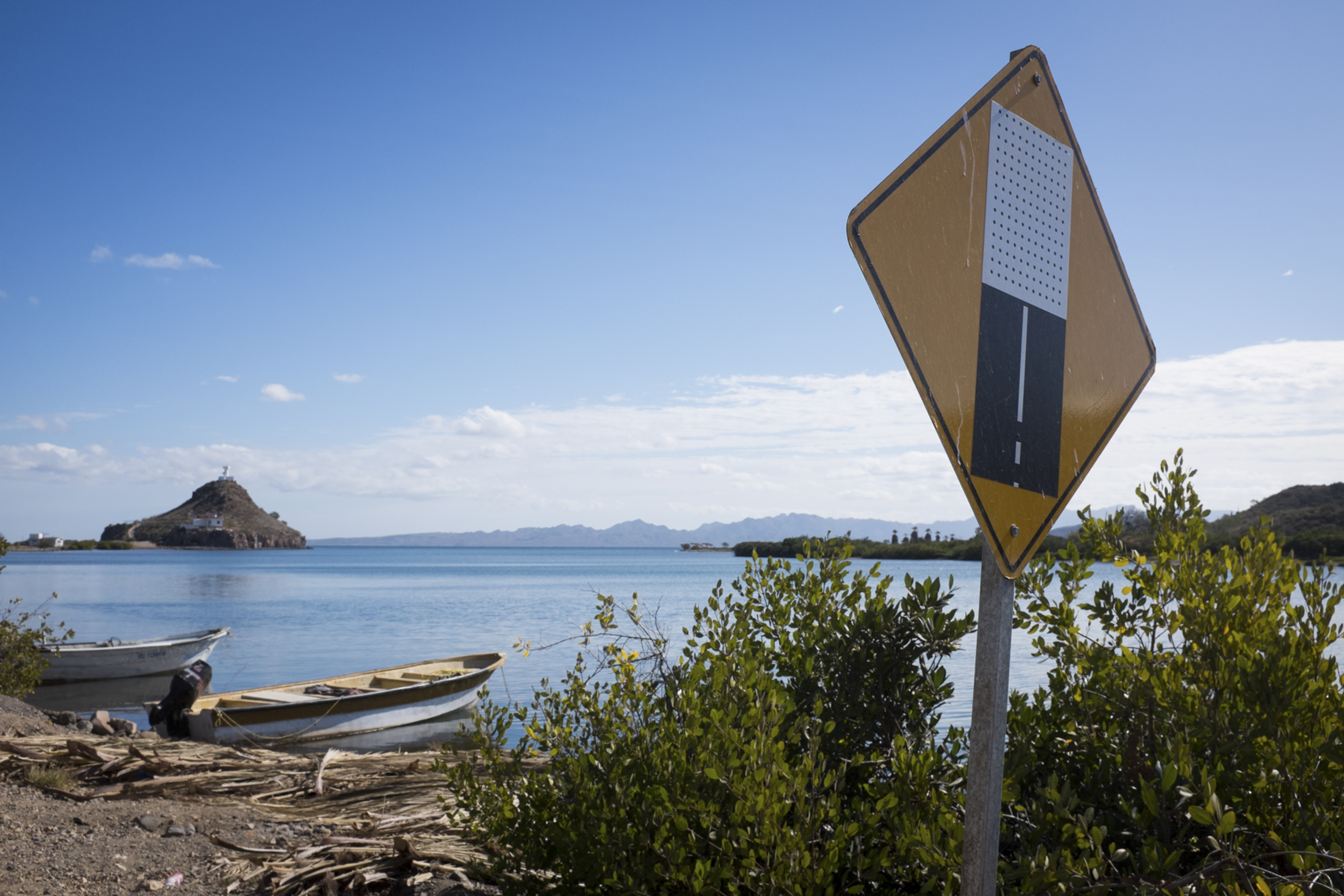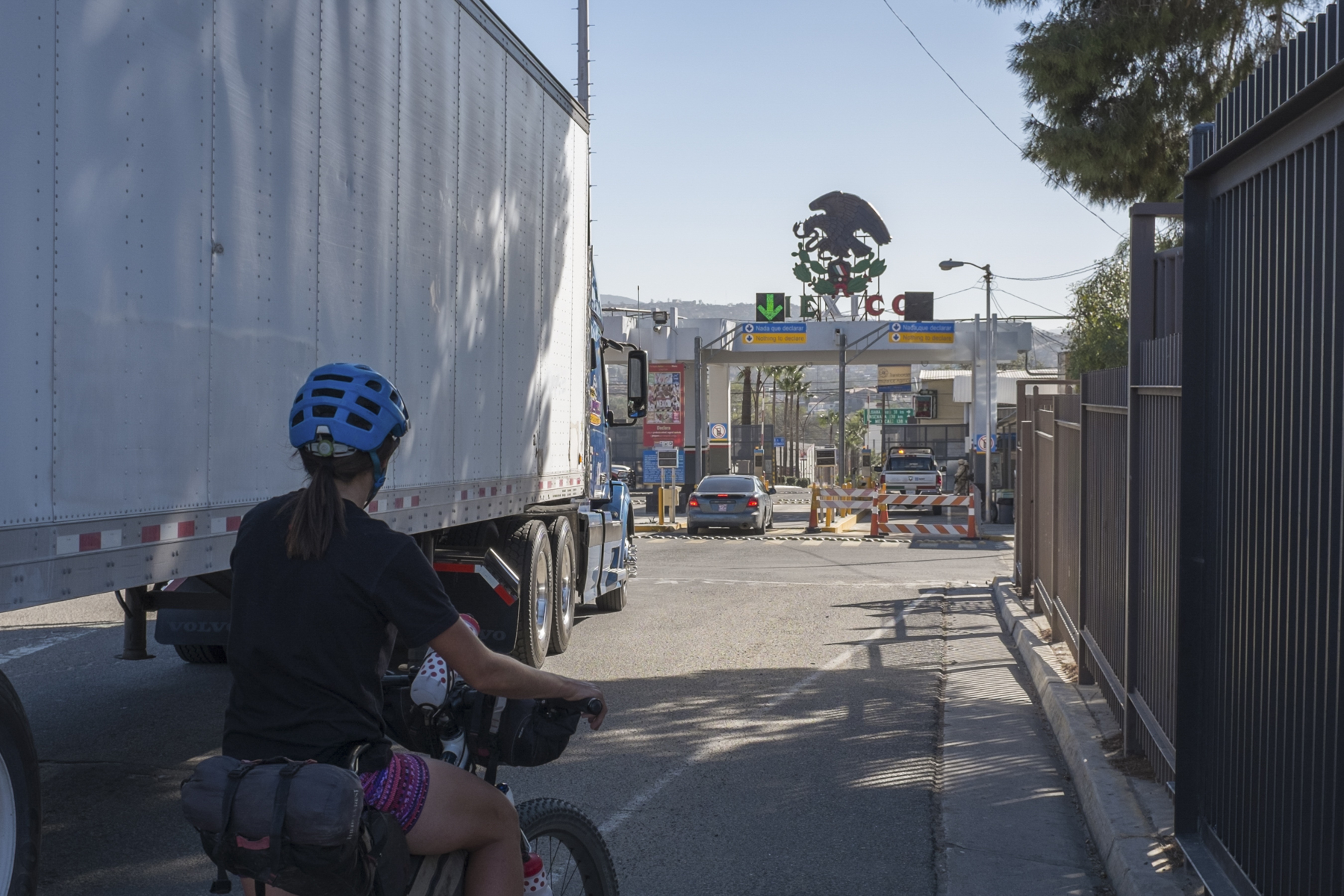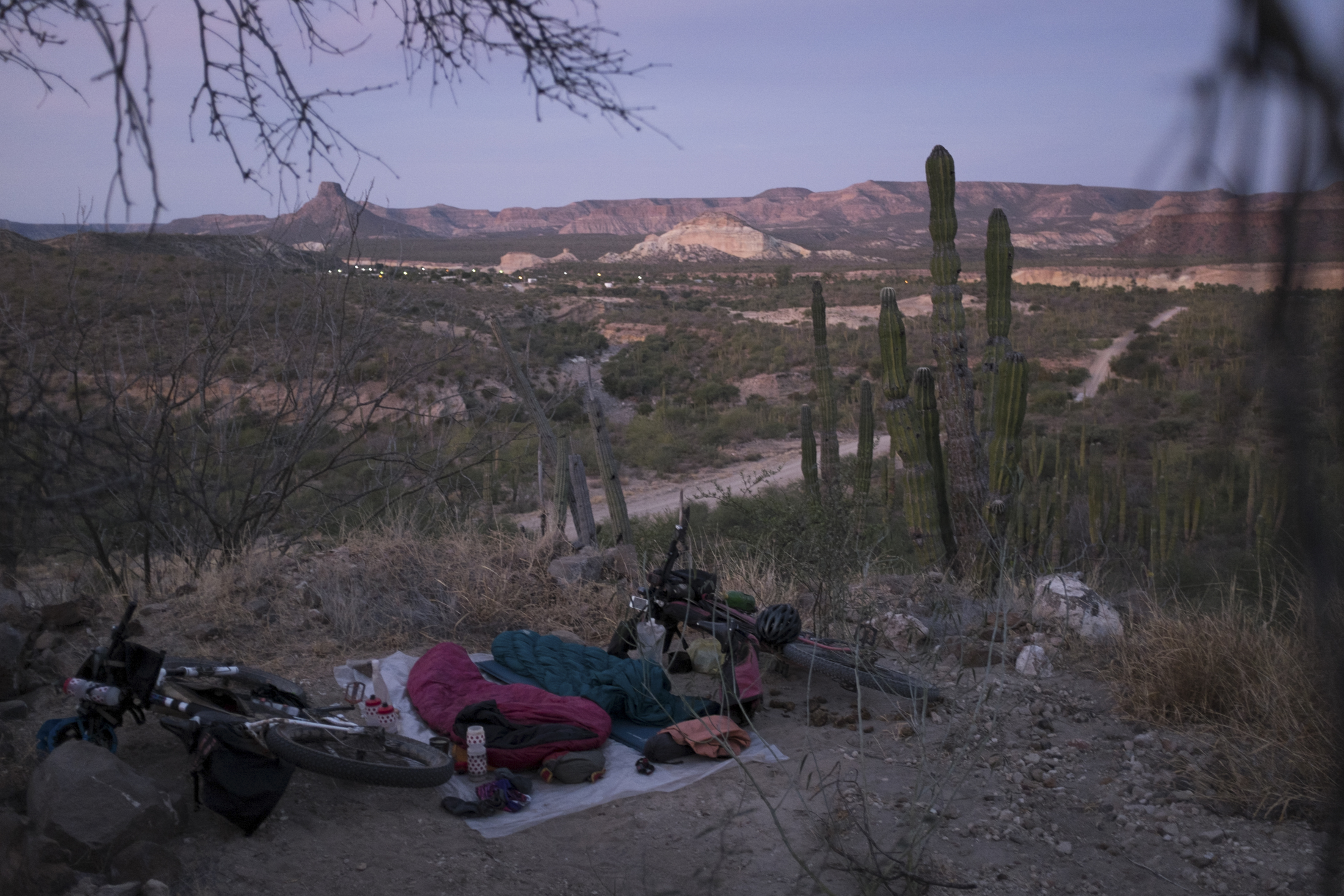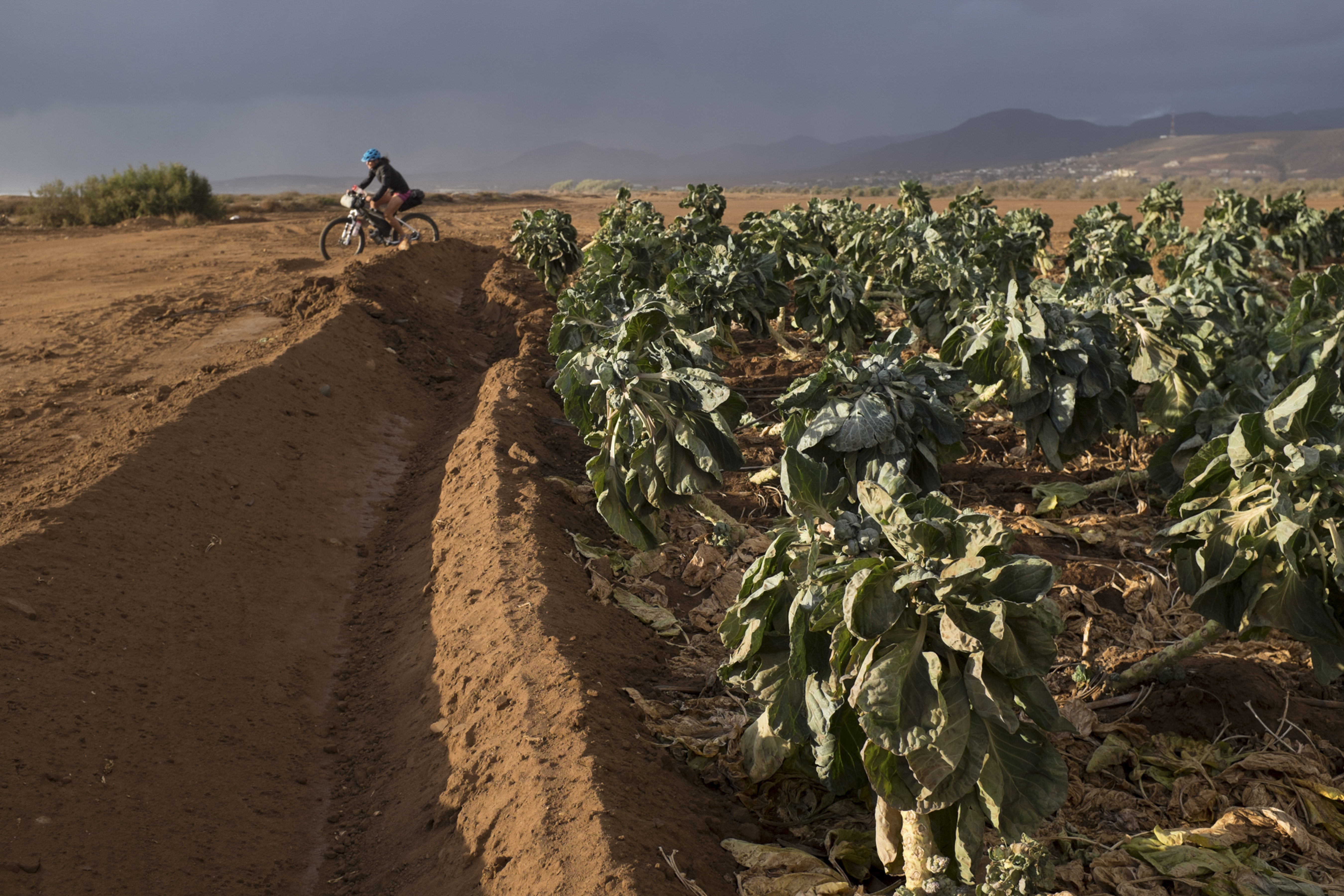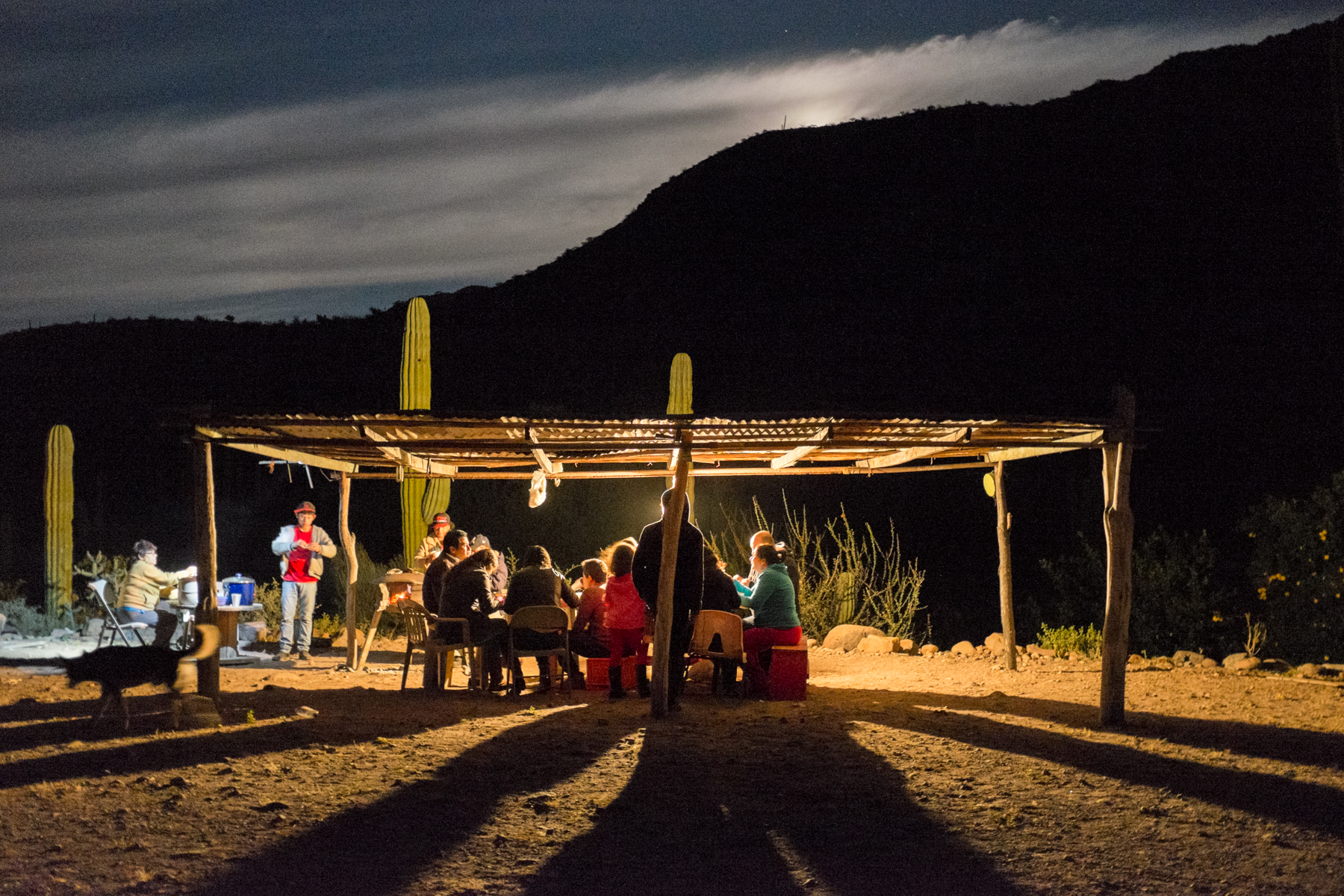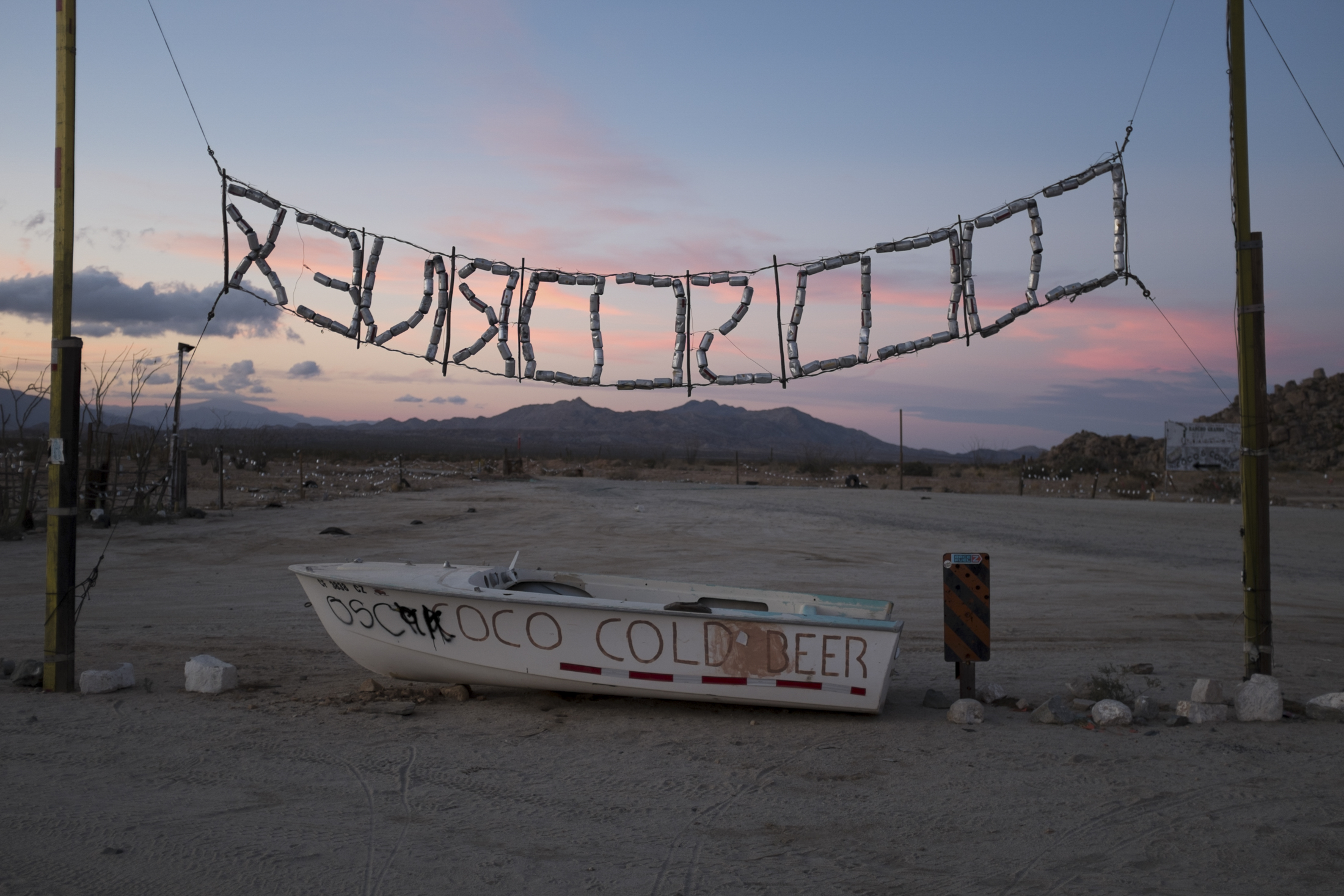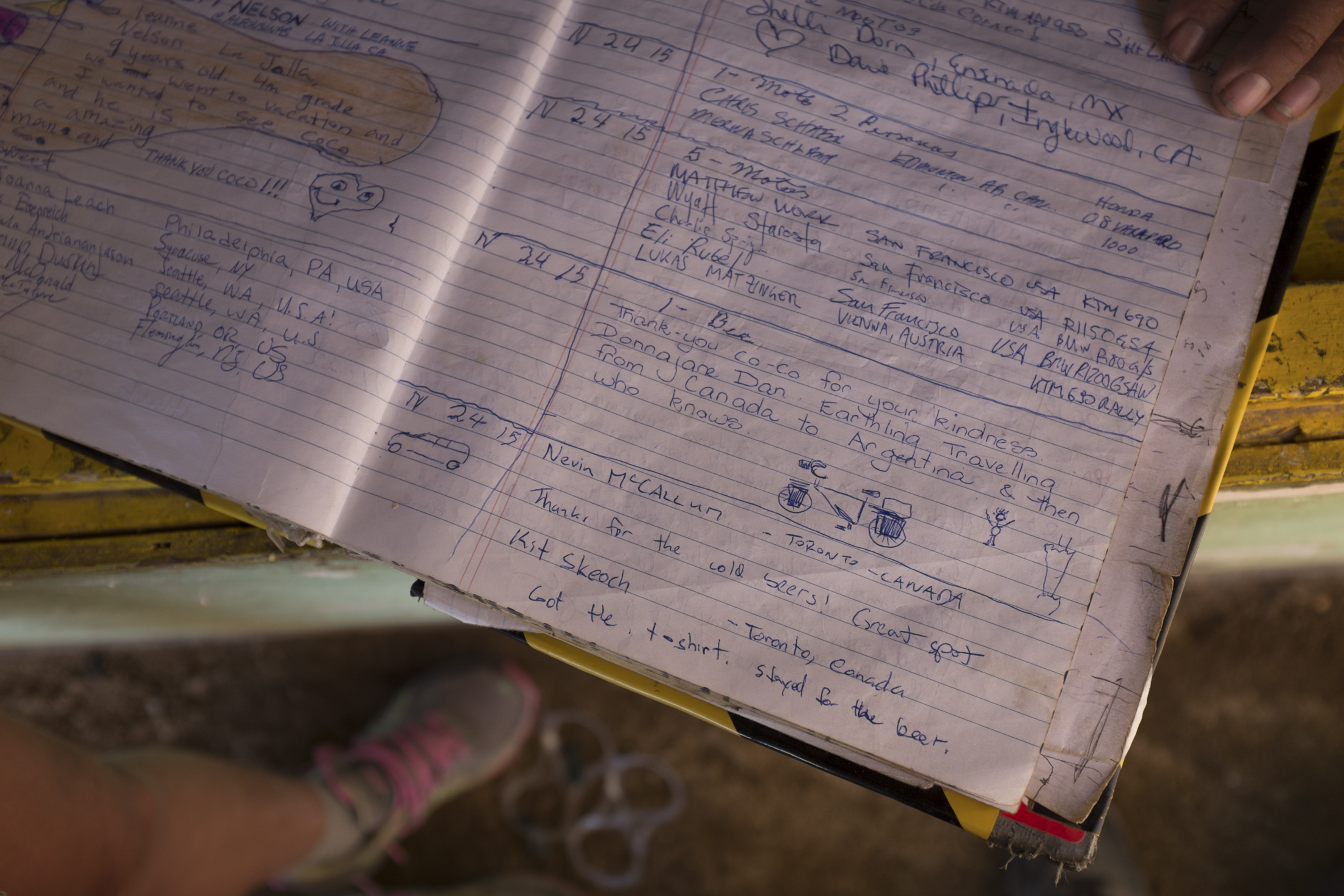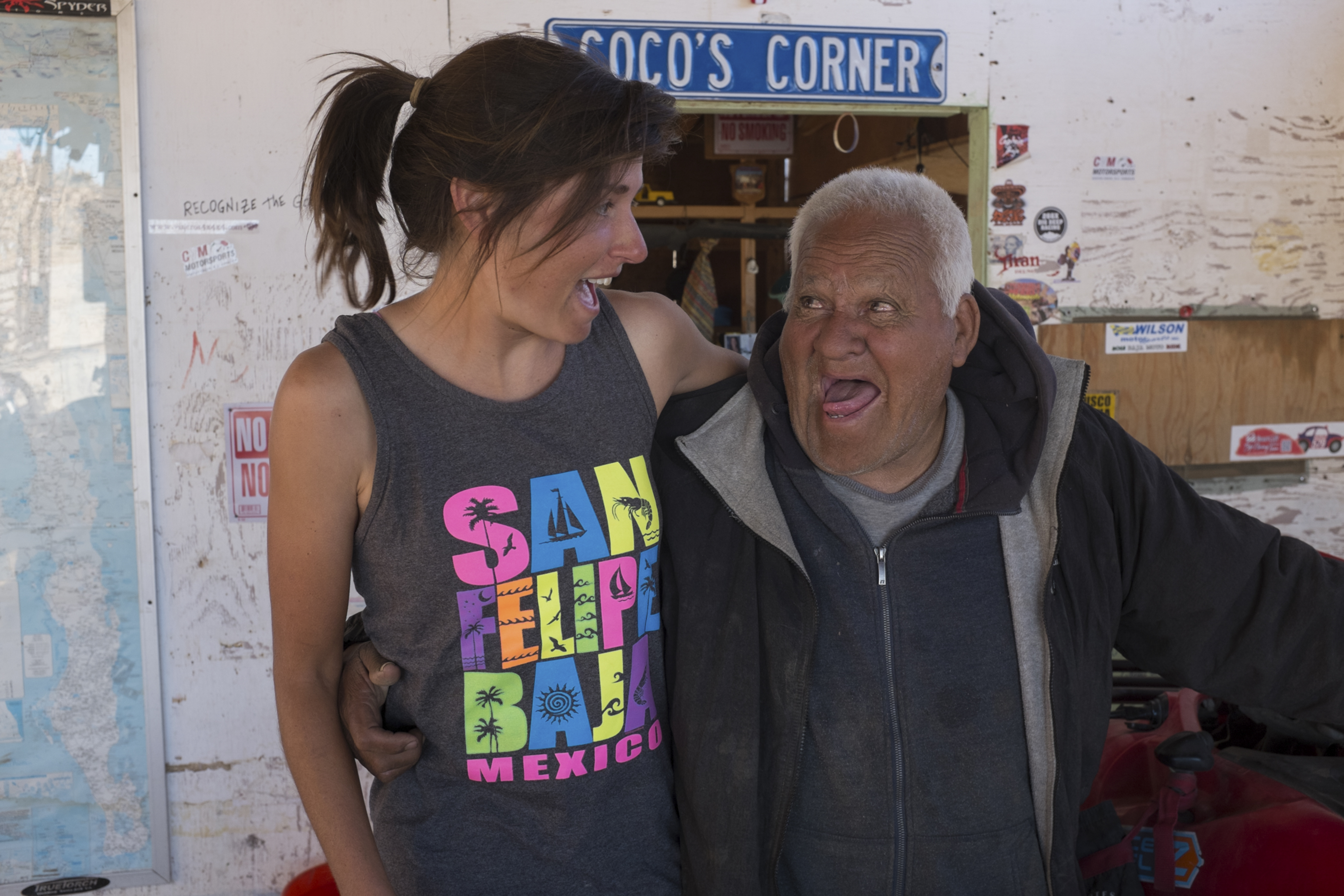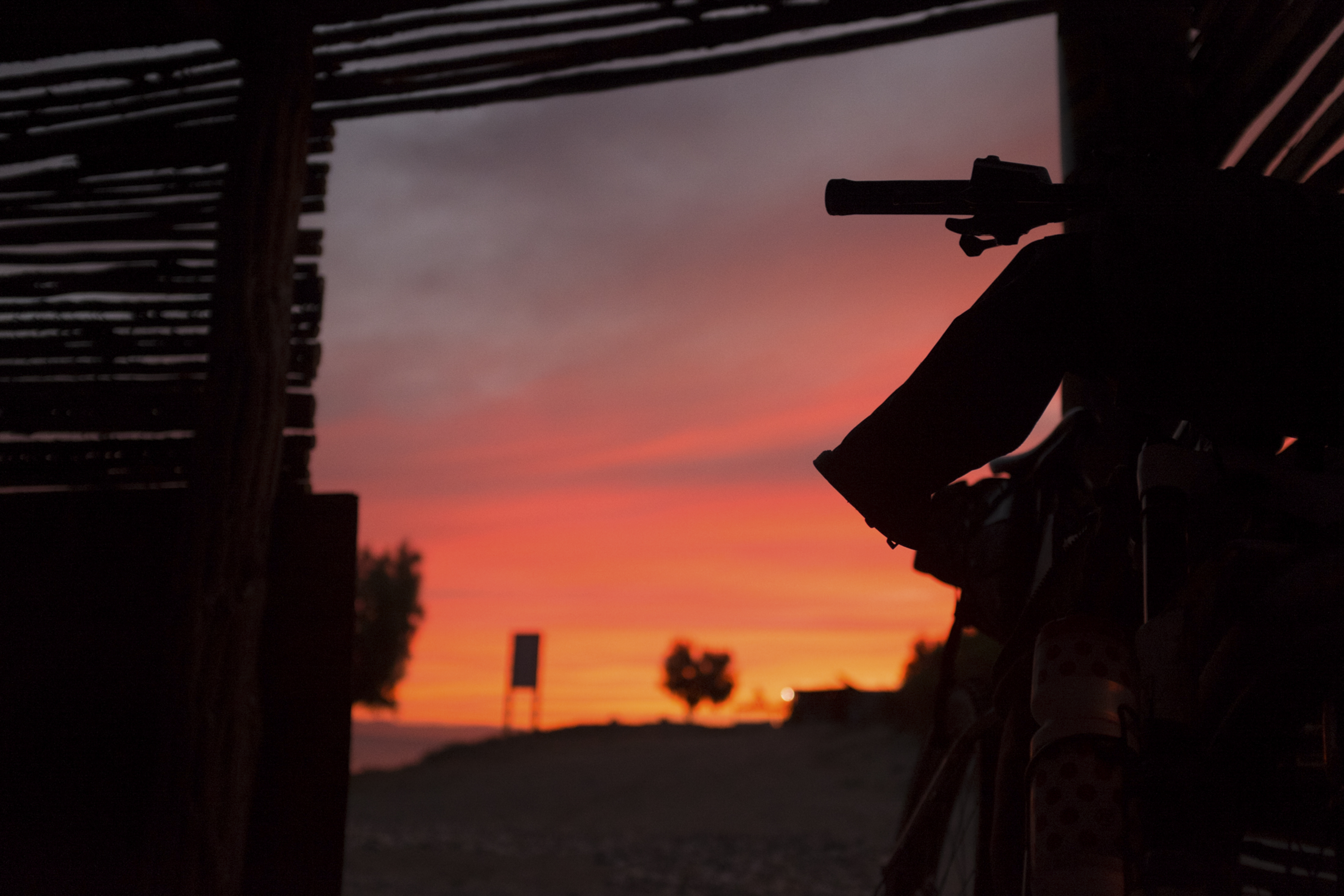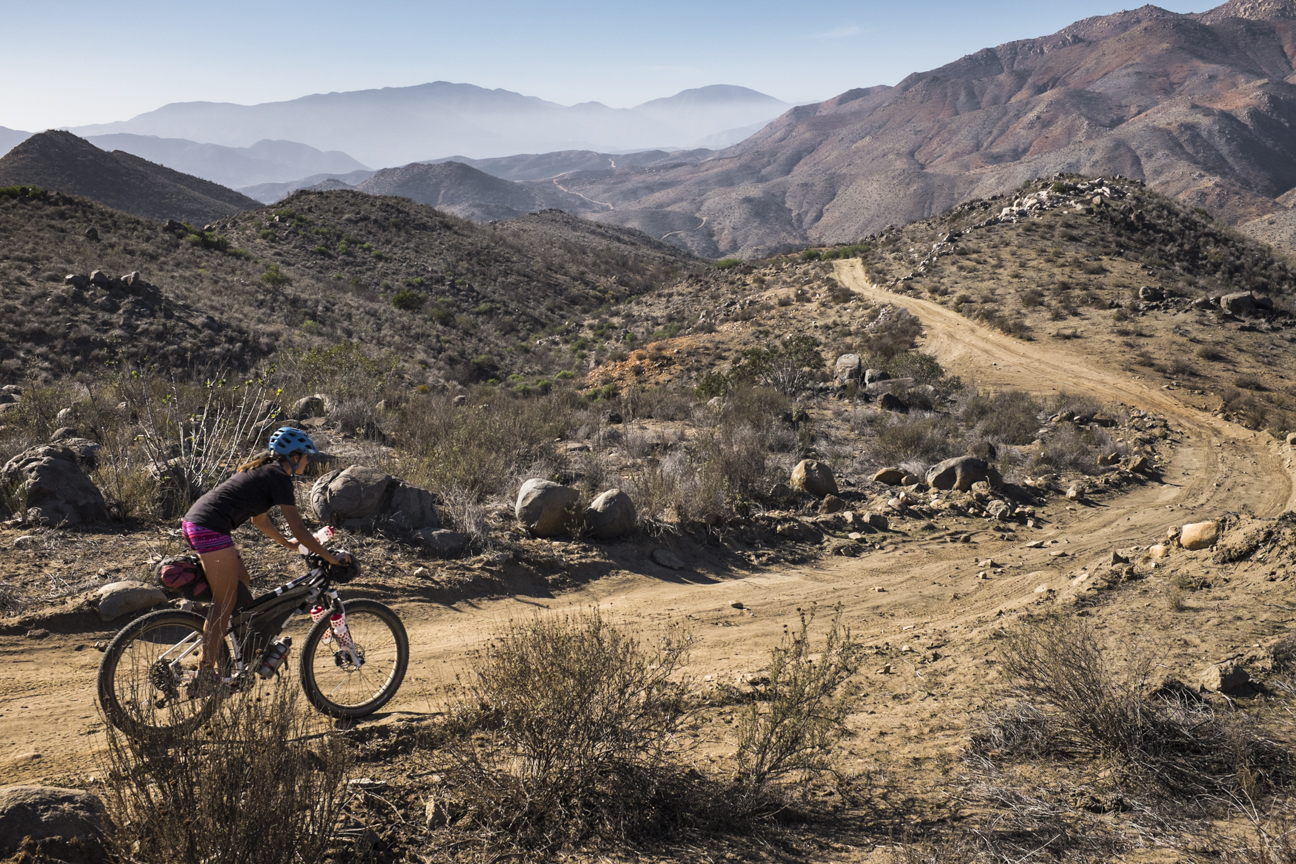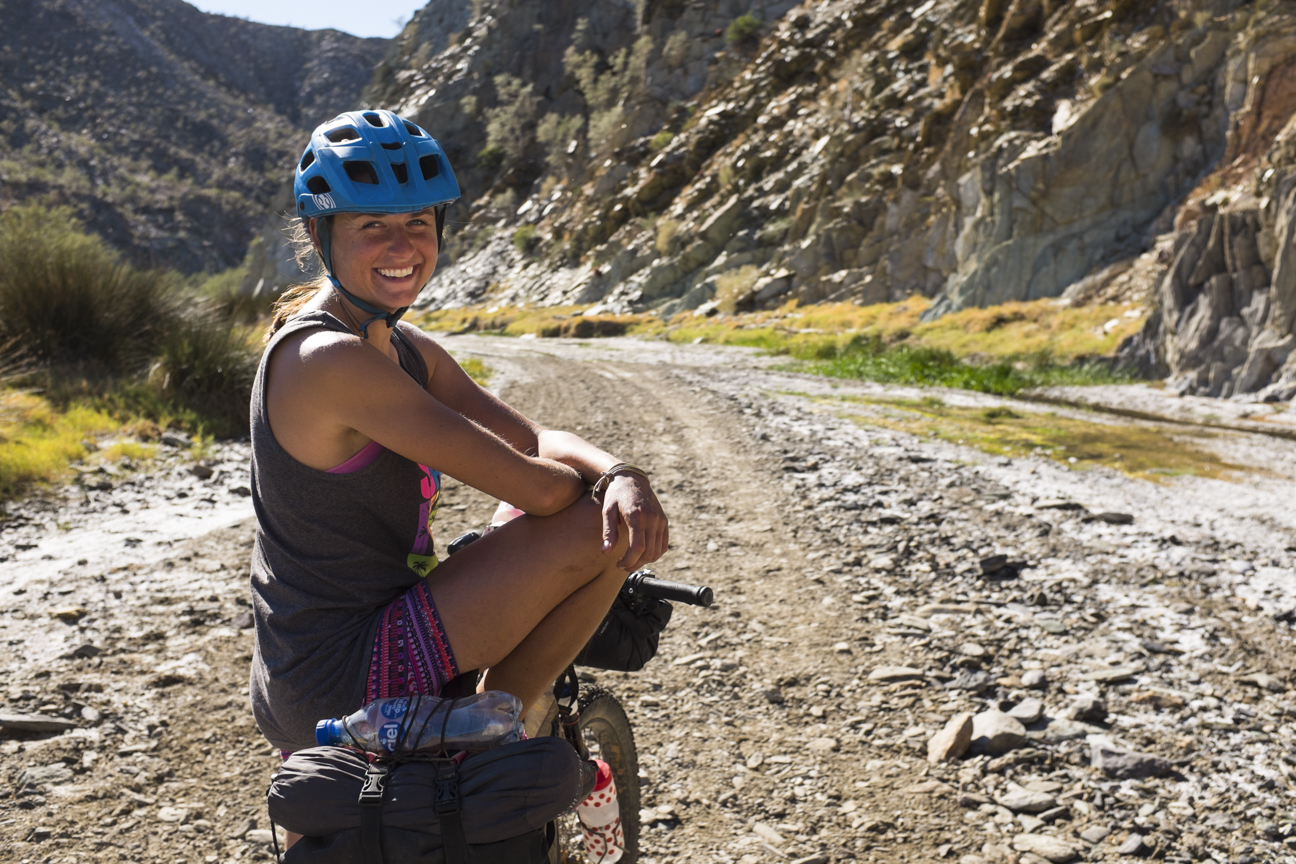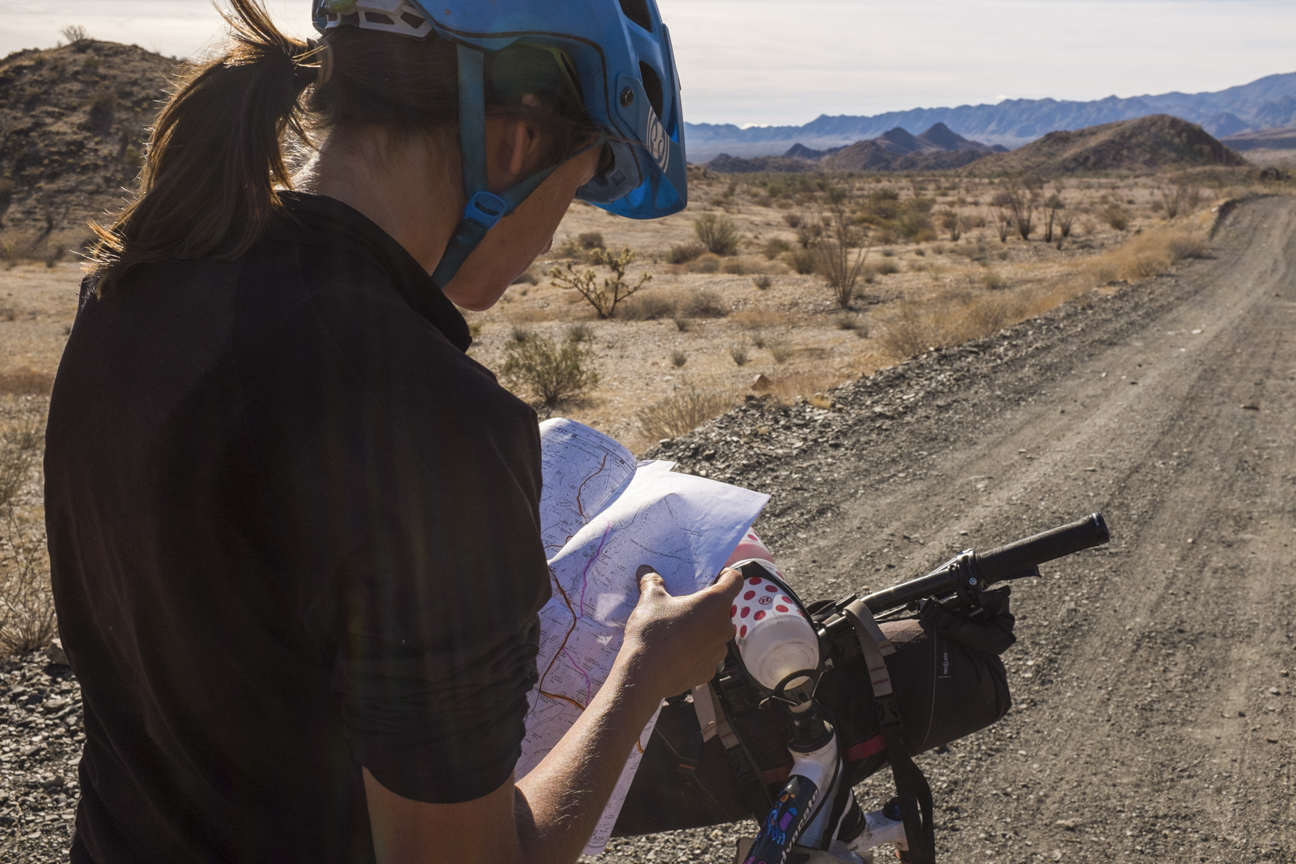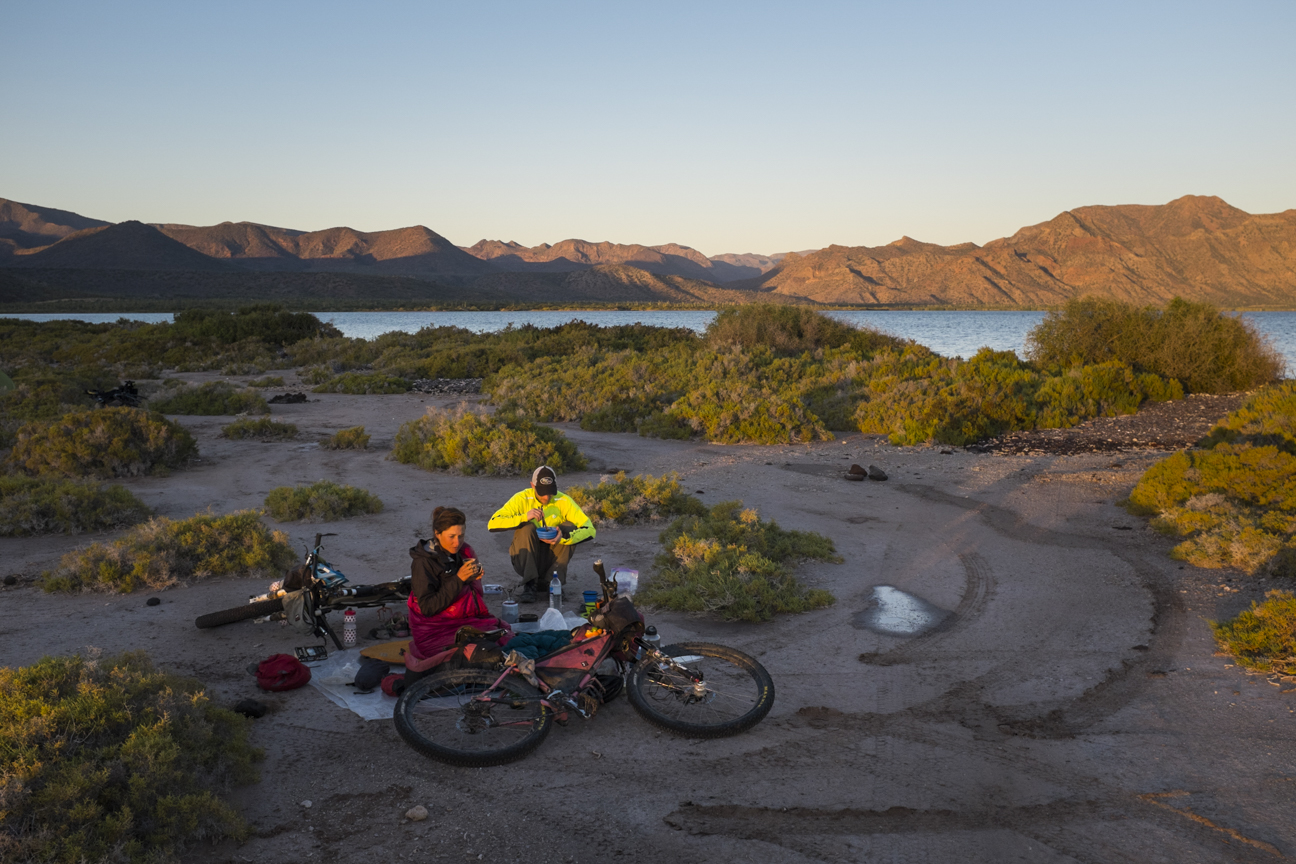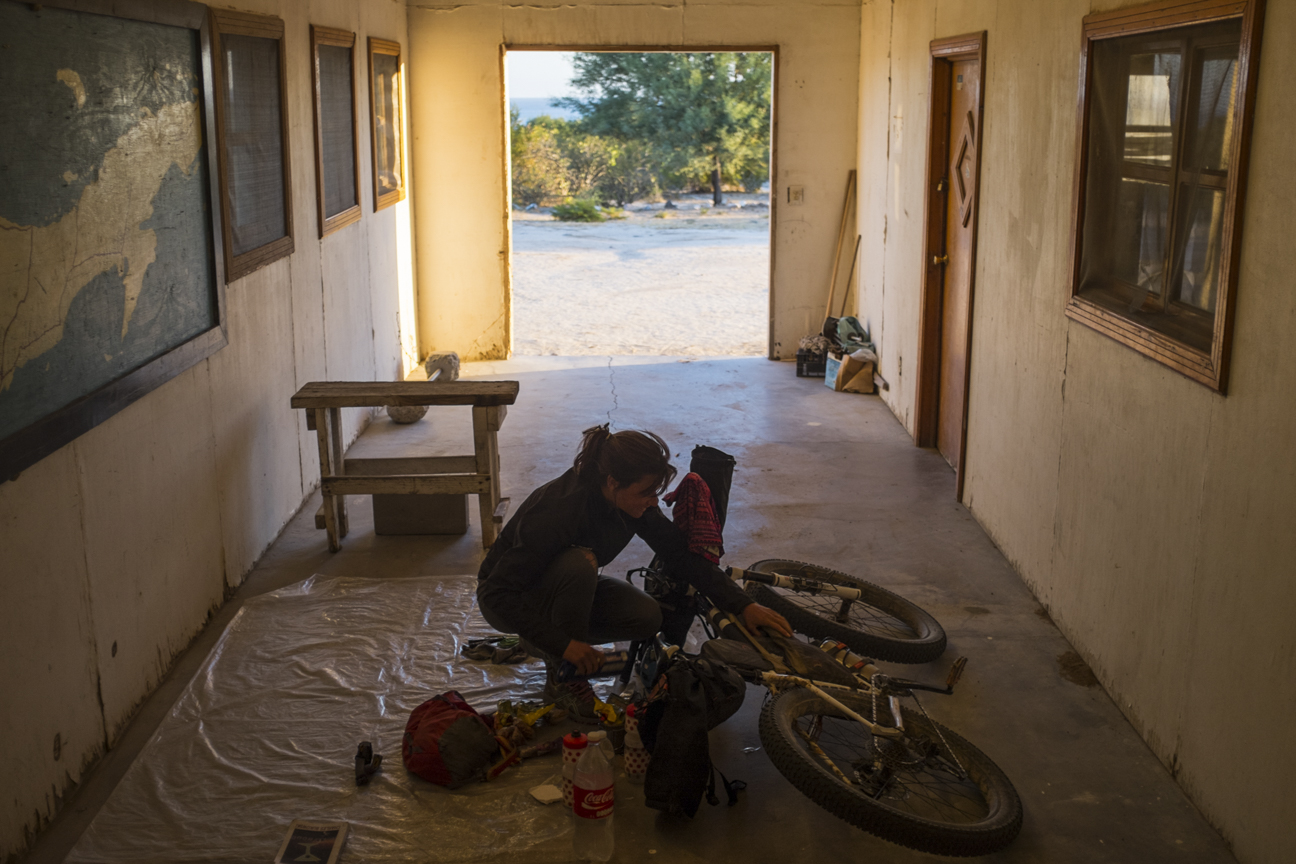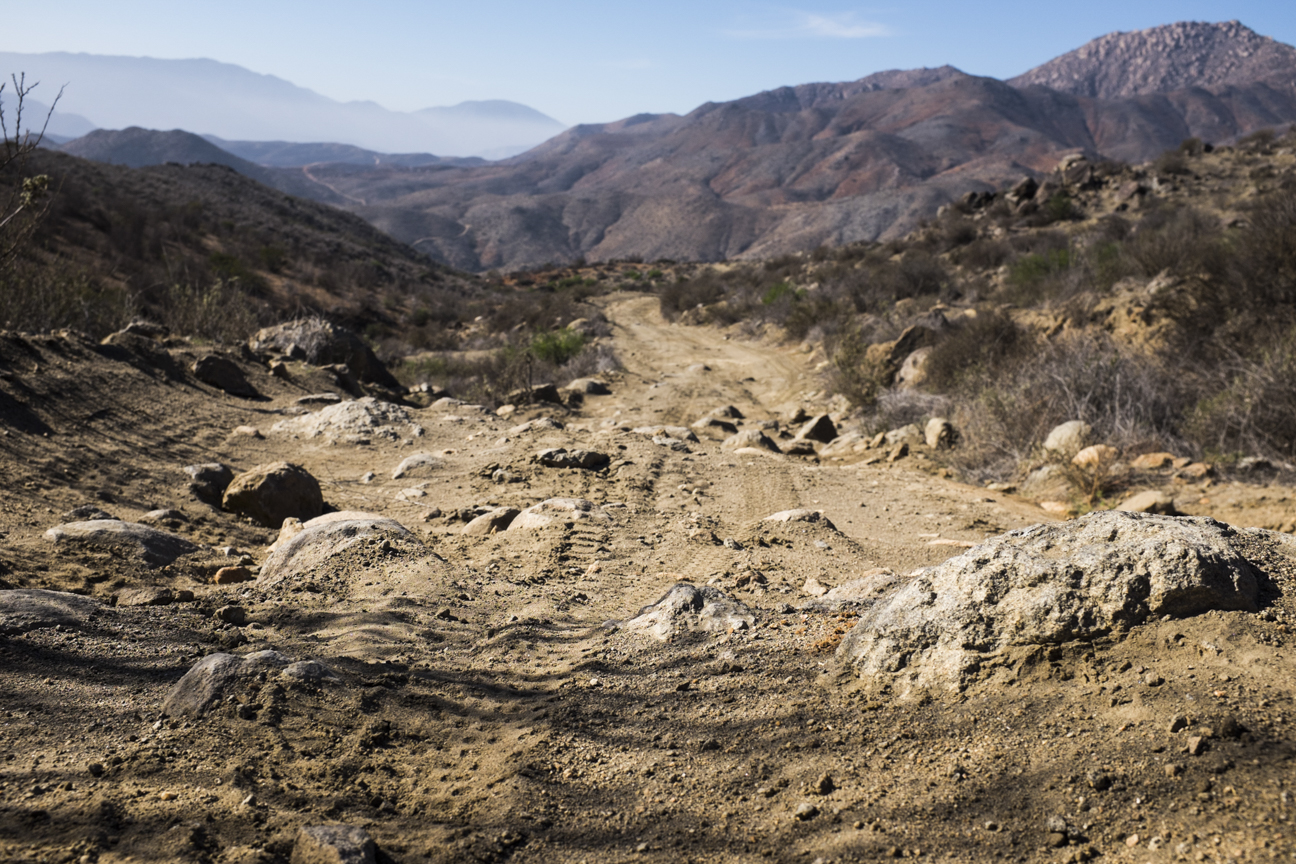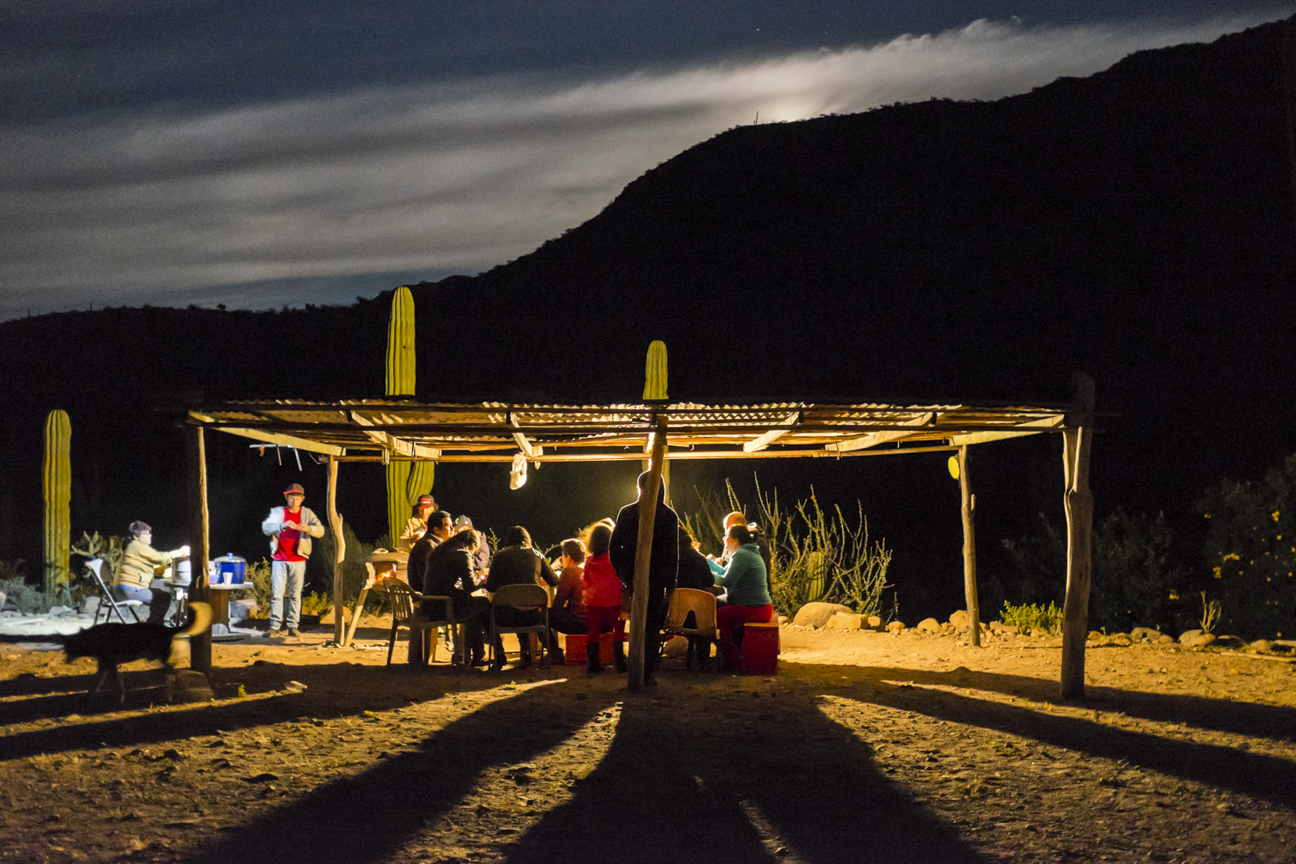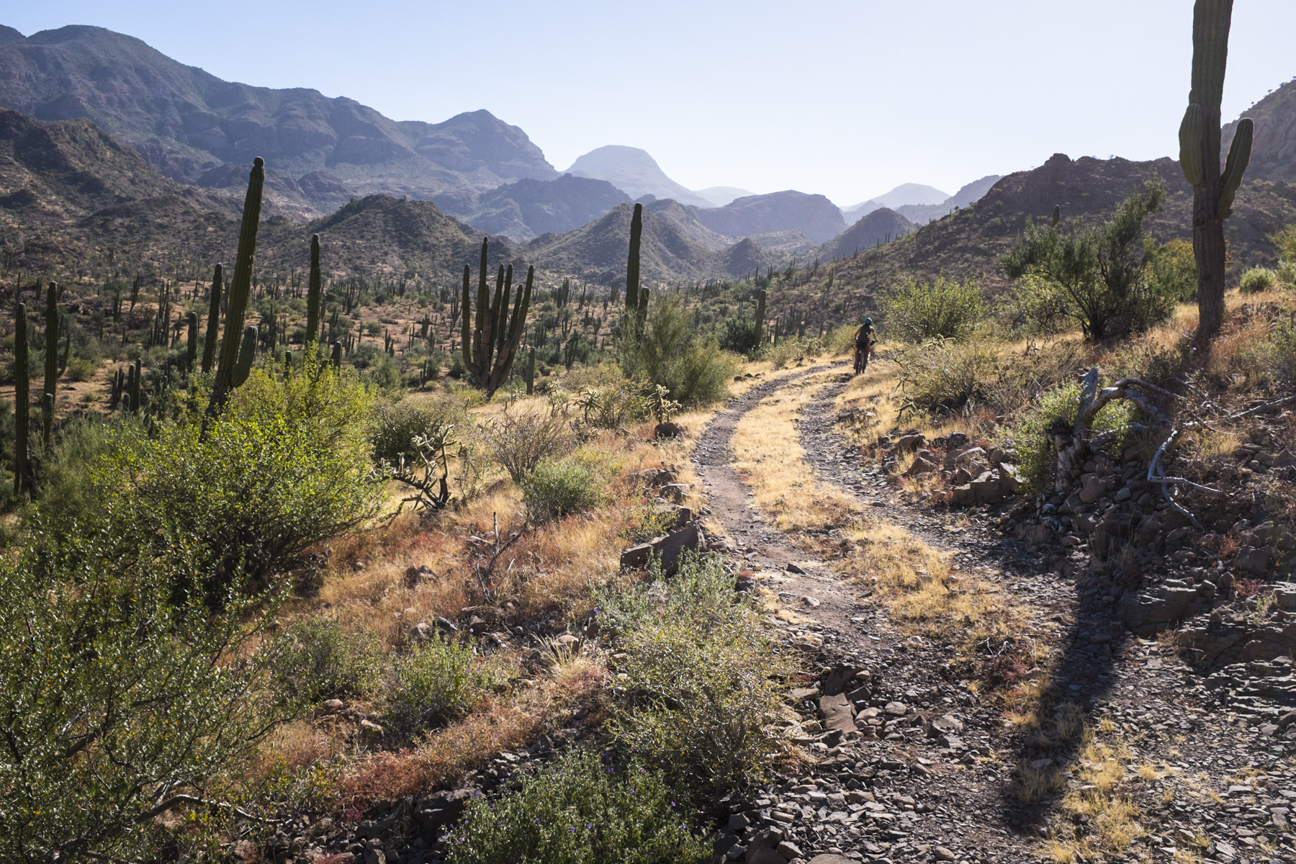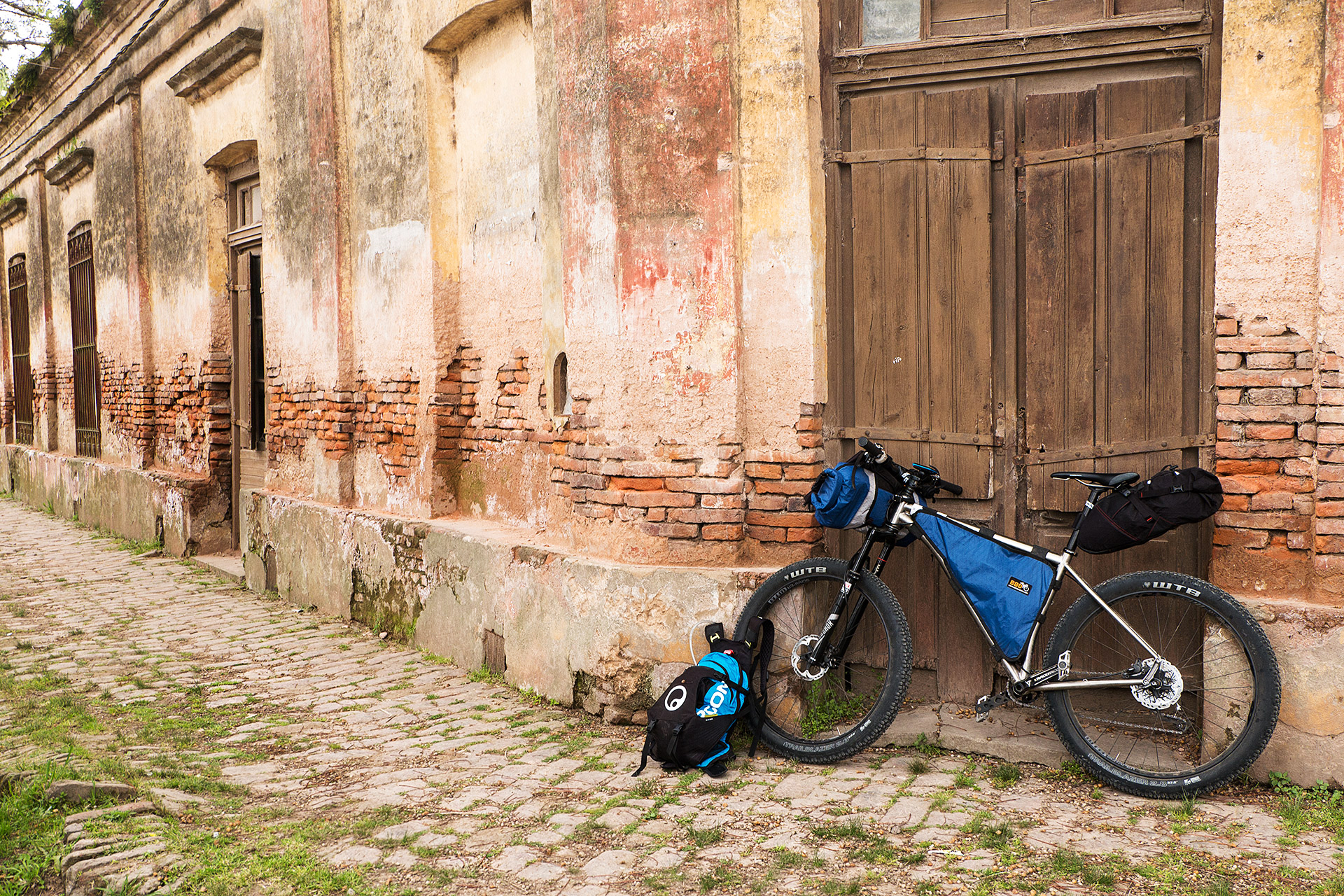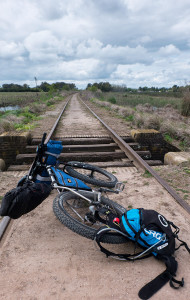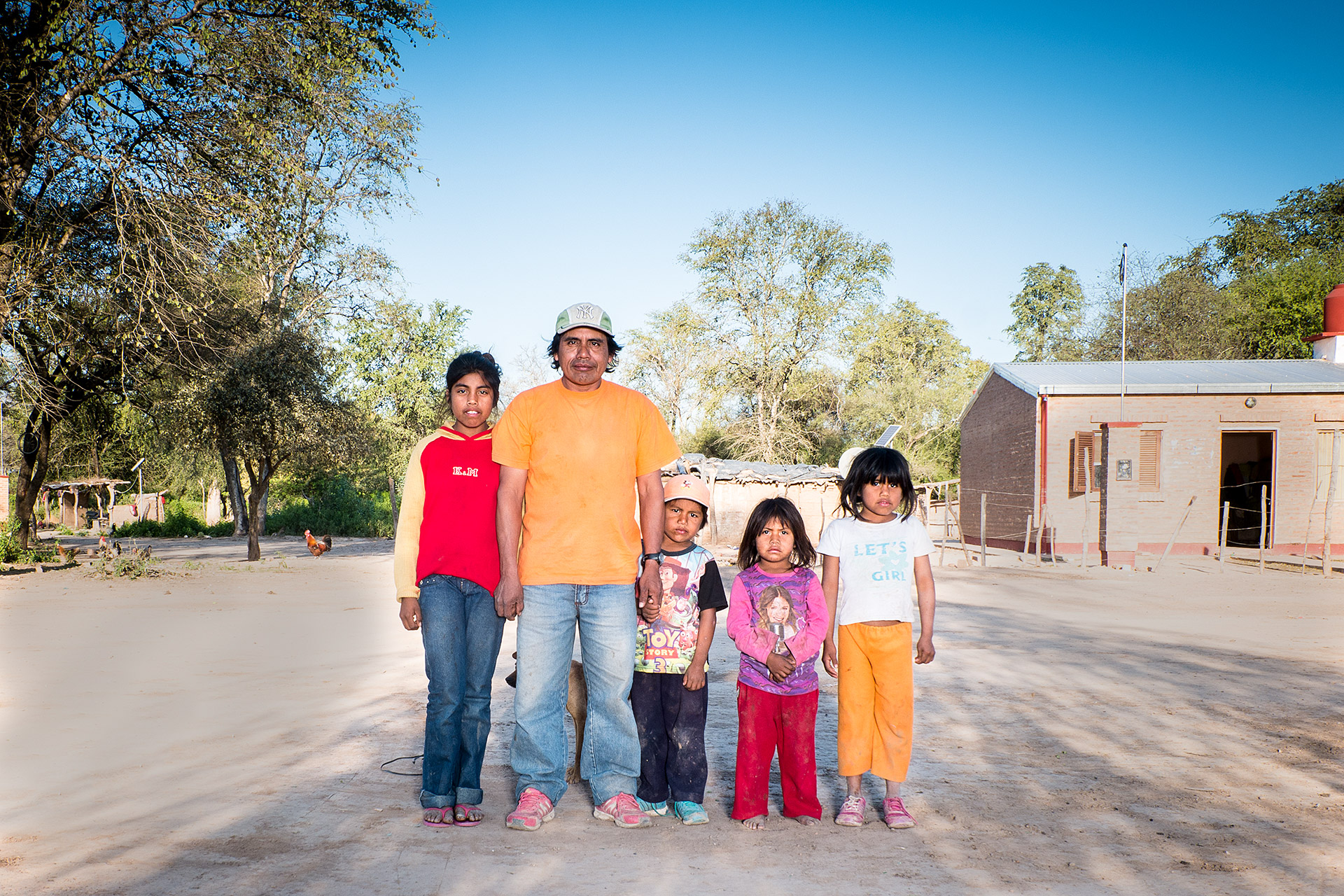Building The Baja Divide: 12 Days Towards Christmas
Words by Lael Wilcox, Photos by Nicholas Carman
In San Diego, we photocopy a colored atlas into white and black. We cut the pages down to size and highlight probable routes in orange and possible routes in pink. There remains a lot of black and white in between—lots of unknown and lots of hope. We trace our fingers over thin lines, then dotted lines—over mountain ranges and to the sea. Maybe this road actually goes through? Could we ride there? If we can’t ride, could we push our bikes and make it anyway? Let’s go try. How else do people get there? Who lives there? What do they do? Let’s go see.
We take a ferry to Coronado. Saying goodbye to my godmother in the morning, we ride the Silver Strand to Chula Vista and to a dirt road over Otay Mountain. From the top, all alone, we can see both San Diego and Tijuana. Both America and Mexico—where we came from and where we’re going.
We descend to the pavement and drink soda in the shade at Barrett Junction. We pass a road sign to Campo, the start of the Pacific Crest Trail. We continue to Tecate, the border crossing. I sit in a customs office on the American side, while Nick goes to find pesos to pay for the tourist visa. He returns to retrieve his passport and gives me a cucumber-lime Gatorade while I wait. It’s delicious.
On December 8, a couple stamps later, we cross the border to Baja. We pedal through the gate, to Tecate and pass a tree-lined plaza. Old men play dominoes on park benches. We don’t stop because we’re on the hunt for dirt roads to other places.
On the first night, a Mexican businessman that commutes daily to San Diego invites us to camp in his yard. On the second, a shop owner in Ojos Negros invites us to camp out front. We buy a half-pint of Mezcalito. Are you sure you want that? Why not? She’s right, it’s gross.
On the third day we pass vineyards on the way to Santo Tomas and almost make it to the Pacific. We climb steep and camp on a hilltop. In the evening, trucks honk hello from below.
In the morning, motos flash thumbs up as they pass. I wave to their backs. We stop at the top of a climb to look out at the Pacific Ocean. It’s all downhill from here. Let’s ride to the beach! I crash hard on the way down riding too fast into deep sand. I hear my back pop in four places and burp my front tire. Ouch! Nick digs the sand out of the tire bead and swirls Stan’s while I pick the sand out of my teeth and finally sit up. He helps me back onto my bike and we ride slowly to Erendira.
On the fourth evening, brilliant purples and reds paint over dark clouds at sunset. It’s both stunning and menacing. Ripping down the coast with a strong tailwind, we watch the storm brew. We need to find camp. To Nick’s dismay, I stop and steal brussel sprouts growing on tall stalks by the sea. He points to the sky and urges me on.
Shielded on two sides by rock walls, we set the tent up. It’s sandy and the tent stakes hardly hold. Nick stakes and re-stakes. The tent walls flap loudly in the fierce breeze. We’ll be fine. If we have to, we’ll pack up, ride on and look for shelter. Under the cover of the tent, Nick steams the brussel sprouts with onions and tops them with a dry, crumbly sheep cheese. I swear it tastes like clams and drink the tasty broth. It rains in the night and after several hours the wind dies and we fall asleep.
On the fifth day, we cross the primary paved highway, the MEX1, at Colonet. We ride dirt to Ejido Benito Juarez and follow a sandy arroyo away from the village. Fresh water flows through the valley. Behind a fence, I spy fields of tomatillos, but I don’t steal any. The night is clear and we camp under the stars. A heavy wet frost covers our bikes.
The next day we climb to El Coyote and then Mike’s Sky Rancho. We drink beer with Canadian mototourists until dark. One of their Mexican guides, named Oscar, works in a fish plant in Seward in the summer. He packs salmon. You’re from Alaska? Yeah! When you go home to Anchorage, go to Thai Tom’s and tell my boss that Oscar says hi. Where are you biking tomorrow? To Coco’s Corner. You’re going to Coco’s Corner? He’s the greatest! When you see Coco, tell him Oscar from Ensenada says hi.
The Canadian motos invite us to stay for steak dinner, but they’re not cooking the steaks. Oscar and the crew are, they’re running a business. We’d rather not impose and we’re ready to find camp. We pedal away in the dark and across a stream. The sky is overcast and it looks like it’s going to rain again. We ride half an hour uphill to find a flat spot. Then I realize that I lost the tent. Dang! Where is it? Nick says that we’d better retrace our steps. With our lights on, we descend slowly to Mike’s and look hard for the tent. We don’t find it. Well, what now? We could either ask to stay here, pay to stay here or look again. If we stay here, we won’t find the tent and then we won’t have the tent for tomorrow. Let’s go look again. Nick suggests that the tent might be in the stream. I’m sure it’s not. And then, sure enough, there it is in the stream. I let out a cheer because I’m so happy that he’s right and I’m wrong. We’ve got the tent! We climb back to our flat spot and set up camp. Instead of steaks, we eat beans and tortillas and they taste great. Heavy rain pounds through the night.
The morning of day 7 is clear and bright. We roll out of camp and start climbing. The ground is still wet from the night before and it’s muddy. It’s that nasty clay mud that stops bikes dead. The mud cakes on our tires and chains and my chain drops off the ring. I put it back on, but it won’t stay. A few steps later, Nick’s tires clog in his frame. Neither of us can pedal. We start pushing our bikes slowly through the mud. It’s sunny and not a big deal, we’ll walk until we can ride again. Eventually, the sun will dry out the roads—for now the air is cool and it might take a while. We keep pushing.
And then I see them. On the side of the road are two unopened cans of beer. It’s the little things; cold treasure can make all the difference on a muddy forced hike-a-bike. We stop in the sun, on the side of the road to drink the beer. Meanwhile, a big white pick-up approaches, engine roaring and sliding all over the road. It’s Oscar from Ensenada! Want a ride? That’d be great!
We put the bikes in the bed of the truck and take a ride to the MX3. Back on the bikes, we rip pavement with a tailwind 60 miles to San Felipe, a tourist town. We stay in a hotel for three days and watch full-length movies on YouTube and eat tacos and write.
On day 9 we head for Coco’s Corner and stop short at Bahia Gonzaga. At the end of a paved road, on the other side of a military checkpoint, there is a really nice store. The owners are having a Christmas party and they invite us to join them. We all dance to loud music and drink Tecate Light and eat cake. We camp on the beach nearby and return to the store in the morning to fill up on water. A middle-aged man in a comboy hat asks if he can try reading my Bukowski novel. He does a good job sounding out the words. He wants to learn English so he can drive a truck in Canada. I see his son eyeing my bike. I ask him if he wants to try and ride it. First he shrugs no and I ask again and he agrees. He barely stands over the frame, but he pumps on the suspension fork and he knows how to ride. It’s awesome!
On day 10 we make it to Coco’s and stop early. He insists that we stay. Coco is alive and well! He’s the greatest. That night, a man arrives at Coco’s Corner. His truck has a flat tire and his family is waiting with the truck and he can’t get the lug nuts loose. Coco—it should be made clear that he has no legs—goes out to help with the truck. We make egg and bean burritos and leave one on a plate for Coco when he returns. In the morning I sign his guest book before we leave.
On day 11 we camp in a half built house just above Bahia Los Angeles. The four walls protect us from the wind. The un-paned windows give us a view of the bay, and the lack of roof—a view of the stars.
On day 12 we eat tacos with Pancho in San Rafael. Pancho lives in a trailer above the beach. He fishes when he wants to and he rolls fresh flour tortillas when he wants them. He fries everything on a propane stove top and I swear they are the most delicious fish tacos I’ve ever tasted.
It’s December 20, four days to Christmas and we’re half-way down the peninsula. We pedal across the imaginary border from Baja California Norte to Baja California Sur. It only gets better from here.
The Baja Divide is a projected 2000-mile off-pavement touring route from San Diego, CA to the southern tip of the Baja California Sur. Lael Wilcox and her partner Nicholas Carman have spent two months researching the route, and have recently returned to San Diego to start a second routefinding mission down the peninsula. A digital track will be published by summer 2016, with additional guiding resources scheduled to be published later in the year, leading up to the inaugural group start on the route on January 2, 2017. This group start—neither a group tour nor a race—is a way to encourage people to ride the route self-supported, at their own pace, by starting amidst a community of like-minded riders. Lael is riding a 27.5+ Advocate Hayduke. Learn more at www.bajadivide.com.
